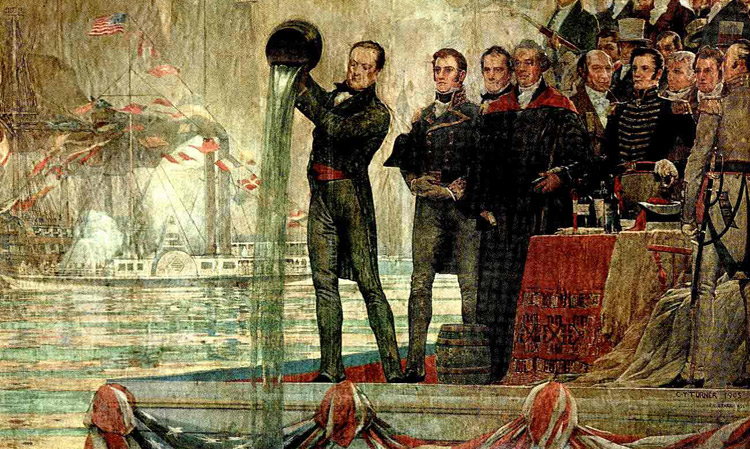A bold dream to connect the Hudson to the Great Lakes by canal created a transportation revolution.
-
Winter 2010
Volume59Issue4

As mayor of New York City and later as governor of New York State, De Witt Clinton crusaded so zealously for a canal connecting Albany to Buffalo that the project became known as “Clinton’s Ditch.” It was a dream of pharaonic proportions—a 363-mile-long artificial waterway that most people considered impossible.
President Thomas Jefferson called it “little short of madness.” Clinton’s Tammany Hall opponents denounced it as a costly folly and depicted it—not incorrectly—as a vehicle for his political ambitions.
But Clinton and a handful of stubborn visionaries would prove Jefferson and the other doubters wrong. In 1810, he convinced the New York State legislature to create a commission to explore and survey the best possible route. When President James Madison declined to provide federal money, Clinton, undeterred, persuaded the state to proceed on its own. On July 4, 1817, three days after he took office as governor, work began on the state-owned, state-financed, and state-run enterprise.
Clinton’s stubborn determination was more than equaled by the ingenuity of the canal’s engineers, who learned their trade on the job, and by the dedication of the laborers, many of them recent arrivals from Ireland and Wales, who dug it with picks and shovels. When they finished in 1825—two years ahead of schedule—they had forced their way through untracked forests, across miasmatic swamps, and over rocky escarpments. They dammed creeks, spanned valleys with 18 stately aqueducts, and devised 83 massive stone locks to compensate for the 660-foot descent from Lake Erie to the Hudson. One summer, in the Montezuma Marsh west of Syracuse, more than a thousand men died of malaria.
On the morning of October 26, 1825, the roar of cannon fire bisected the state of New York, moving west to east, one shot per minute for 90 minutes. It began in the frontier hamlet of Buffalo on the eastern edge of Lake Erie. From there at regular intervals it punctuated the route of a narrow waterway, 40 feet wide by 4 feet deep, reaching all the way to the Hudson River at Albany. The thunderous salute continued south along the Hudson to New York City, joyously proclaiming the completion of “the eighth wonder of the world”—the Erie Canal. In the decades that followed, this marvel would confirm New York’s preeminence among American cities and keep the rapidly developing American West firmly tethered to the Eastern Seaboard.
The impact of the canal was immediate and far-reaching. Within a year, Erie boatmen were steering 42 horse- or mule-drawn barges a day toward New York City laden with timber, grain, and other foodstuffs (including 435,000 gallons of whiskey) and returning with sugar, coffee, nails, manufactured goods—and settlers. Within a decade, some 1600 barges worked the canal, generating enough revenue in tolls to pay off the $7 million construction bill while driving down shipping costs from Manhattan to Lake Erie from a hundred dollars per ton to under nine. Freight that once rafted south down the Ohio River reversed course and headed east. Within 15 years New York was by far the busiest port in the nation, handling more commerce than New Orleans, Baltimore, and Boston combined.
Concurrently, the quickening pace of commerce spurred the growth of Manhattan exchanges, banks, and insurance companies, fixing “Wall Street” firmly in the national lexicon as a synonym of American capitalism. The promise of rapid access to cheap land in the Ohio and Mississippi valleys meanwhile pulled tens of thousands of immigrants to the city, boosting its population from 124,000 in 1820 to more than 300,000 in 1840 and better than 800,000 by 1860—far outstripping Philadelphia, its nearest rival. No less dramatic were the waves of prosperity that rolled through upstate hamlets lining the canal’s route: Rochester, Syracuse, Rome, Utica, Schenectady, Albany.
At the western terminus of the canal, Buffalo saw its population surge from 200 in 1820 to more than 18,000 by 1840.
It’s difficult to imagine how any of this could have happened, or could have happened so swiftly, had the canal never been built. Then, too, without the canal—and without the railroads that would later be financed out of profits generated by the canal—it’s conceivable that the trans-Appalachian West would have developed independently of the United States. No canal, no country stretching across North America, from sea to shining sea.

